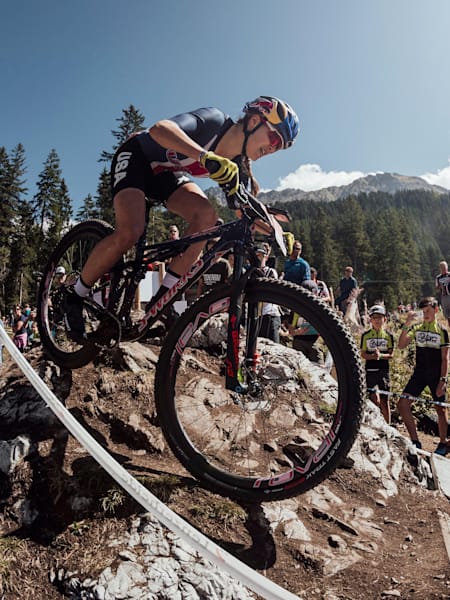Bike
Cast you mind back 10 years and the idea of rocking up at an XC race with 740mm wide bars would be tantamount to heresy amongst the Lycra-clad, leg-shaving world. Most riders were on 600mm and under, with the firm belief that narrower was better.
Since then times have changed and manufacturers regularly spec 740mm wide handlebars as stock on all of their XC bikes. Cannondale have even specced their Scalpel si model with 760mm bars, which is pretty bonkers wide for an XC bike.
But hey, there must be some method behind their madness and if the pros are doing it, then it’s got to be cool, right? As ever it’s not quite that simple, so we’ve compiled a list of the pros and cons of wider bars for XC racing.
Pros
1. Control
Just like our trail and enduro riding cousins, wider bars help to give you more control on the steep and technical terrain that’s becoming more common in the XC world.
This is down to the extra leverage you get with wider bars. Simply put, they’ll help you control the front wheel better when things get really fast and rough.
2. Position on the bike
In a sport where breathing is critical, many riders report that wider bars help them to open up their airways and take in more oxygen. Whether or not this is actually true is hard to say, but if something feels good, then it probably won’t be doing you any harm on the bike.
Cons
1. They take up more space
More control, more fun, sounds too good to be true, right? In a word, yes, wider bars do come with some compromises, mainly because they just make you so big. The two places this can become a problem is during race starts and in tree lined singletrack.
XC race starts are about as fast and furious as bike racing gets; it’s a matter of elbows out and get ready to dive into any gap you see (regardless of how small) to gain an advantage. Obviously having wider bars hinders the size of the gap you can fit into, meaning you could end up losing vital places during that all-important start.
The same goes for narrow tree lined singletrack, where the wider your bars are the harder it is to squeeze through the gaps as quickly and efficiently as possible. And, even if you’re absolutely sure you can fit through that super tight gap, the narrowing perspective can still cause you to slow down, ultimately costing you precious time.
2. Wider bars might not fit your body type
If you’re on the smaller side and/or have narrow shoulders you might find that wider bars just don’t suit your body type, as you have to stretch too far and end up feeling uncomfortable.
What about the professionals?
Interestingly many professionals run their bars on the narrower side by today’s standards. Take a look at possibly the greatest XC rider of all time Nino Schurter’s bike and you’ll see he runs 680mm wide bars.
Even the larger riders such as Jaroslav Kulhavey, run 700mm wide, which comes as a surprise considering he’s well over 6ft tall.
We suspect this is in part due to tradition. These guys would have grown up with narrower bars, so they’ll be used to the way they feel. And of course, the aforementioned ability to squeeze through gaps in a tight racing situation that narrower bars afford you.
Don’t forget your stem
It’s important to note that as bars get wider your stem needs to get shorter in order to keep your weight cantered and the overall ride to feel the same. So, if you end up increasing your bars by 40mm it may be worth thinking about reducing the length of your stem by 10-20mm at the same time.
Summary
There are plenty of great reasons to choose wider bars for XC racing, the extra control they afford on fast technical terrain cannot be overstated. However, if you’re particularly small, ride in areas with lots of tight singletrack, or race week in week out, then it might be worth sticking to a more conservative width such as 700 – 720mm.
And just remember, if you do have wide bars you can always make them narrower by cutting them down, so don’t stress if your new bike comes with some 760mm wide beasts.





